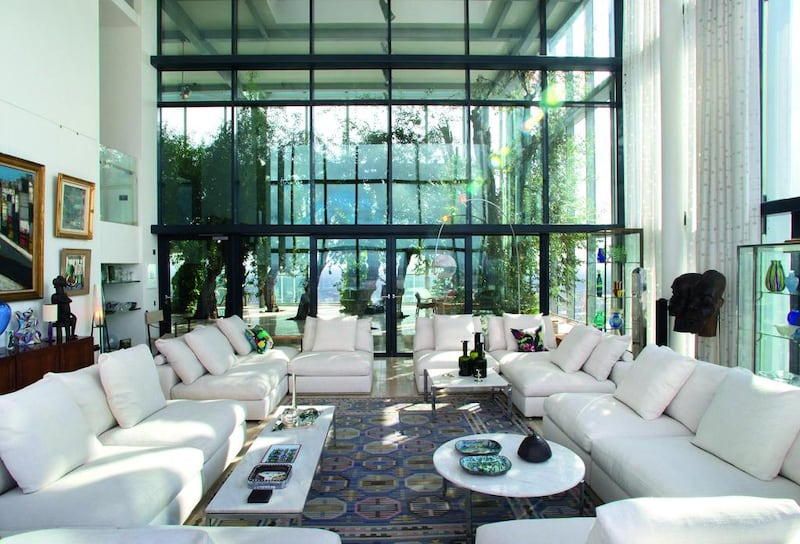From his penthouse at the pinnacle of Manchester’s Beetham Tower, Ian Simpson can look out over the entire city — which is fitting, given that he has been so instrumental in shaping its skyline.
Simpson founded his eponymous architecture firm, Ian Simpson Architects, with his business partner Rachel Haugh in 1987; they went on to become “the” Manchester practice. After an IRA bomb ripped through the heart of Manchester in 1996, the company was “actively involved in the rebuilding of the city centre,” Simpson explains, and was responsible for crafting landmark projects such as No 1 Deansgate and the Urbis museum and exhibition gallery.
In the early 2000s, the practice was commissioned to design Beetham Tower, a 169-metre building on the site of a disused railway viaduct in the centre of Manchester. The tower houses a 279-room Hilton hotel on the first 23 floors, and residential apartments, including a penthouse on floors 47 and 48, on the remaining storeys. The residential and hotel elements are entirely independent, with separate entrances — the building itself cantilevers out on the 24th floor, creating a visual differentiator between the two entities.
With this project, Simpson was presented with a unique opportunity to create a home for himself at the top of the tallest building in the city. It was rumoured at the time that a high-profile member of the Manchester United football squad had bought the penthouse but Simpson acquired the shell and core from the developer before it was ever marketed, and set about creating his dream home.
While much of the company’s work is now in the UK capital — its London portfolio includes high-profile projects such as One Blackfriars and a redevelopment of Battersea Power Station — when it came to his base, Simpson knew that he wanted to be in Manchester. Mancunian by birth, he has an extreme fondness for the city. “I love this city,” says the 58-year-old. “I spent many years in London, but I like the quality of life that we can achieve outside of the capital. It is a nice-scale city — you feel like the individual can make a difference here.”
While 48 storeys may not seem particularly tall for those used to the behemoths lining Sheikh Zayed Road, Beetham Tower caused something of a stir when it was first built. It was the tallest building in Manchester, by some way, not to mention the tallest residential building in the UK and, indeed, Western Europe. It is also an undeniably modern-looking, glass-fronted thing, something of an anomaly in a predominantly low-rise, northern city. “In a city the scale of Manchester, it is always going to be controversial if you put up something quite tall,” says Simpson — but he insists that the city was generally welcoming of this new addition.
Jutting out into the skyline for all to see, the building was very much of its era, a pre-recession project that spoke of Manchester’s aspirations — not to mention the then buoyancy of its housing market. “It was a product of a moment of time,” says Simpson, who acknowledges that it would probably be more difficult for something of its kind to be built in the current economic climate. Which only serves to make his home all the more special.
The obvious draw of Simpson’s penthouse is the views. From his “sanctuary at the top of the tower”, but he cannot only look out across Manchester’s city centre, he can also see far beyond to the Peak District and the Pennines; he can see houses and roads, but also hills and national parks; he can see lights at night and the weather rolling in during the day. “The view is constantly changing — that’s one of the nice things about living up high in a city,” he explains.
But while height was one of the apartment’s distinguishing features, the scale — a total area of 12,500 square feet — and volume — which Simpson capitalised on by introducing a double height space, with a seven-metre-high ceiling, in the more formal living room — were equally important. All the rooms flow into each other; the only doors in the entire apartment are in the bedrooms and bathrooms.
Simpson wanted to have spaces that were connected visually but, with an apartment this large, he recognised that there was a danger of it feeling “cavernous and empty”. To introduce a sense of intimacy, he created distinct spaces — the TV area, for example, is warmer, with an earthy colour palette, velvets and orange accents, while the formal living area is starker, with a predominantly white colour scheme.
“One thing I am not is a minimalist,” says Simpson and this is certainly true. His apartment is home to more than 200 chairs (by design greats such as Eero Saarinen, Poul Kjærholm and Franco Albini), which are testament to Simpson’s penchant for midcentury, predominantly Scandinavian furniture.
Accumulated over many years — at auctions and during trips to Copenhagen — the vast collection had to be stored in a number of different locations before it took up residence in Beetham Towers. “They are timeless in terms of design and materiality,” he says. “I like crafted pieces and I tried to thread those into the apartment in different ways.”
And does he use them all? “I do. I use different ones throughout the day. For example, there is a Hans Wegner leather chair with a Giò Ponti footstool that I read the paper in. But it’s not the sort of chair that you can fall asleep in.”
The chairs, the 12,500-square-foot floor plan and the spectacular views would be quite enough to set Simpson’s home apart — but the real pièce de résistance is the seven-metre-high, 45-metre-long conservatory that runs along the south side of the apartment, which is home to about 30 olive trees. The 300-year-old trees — all gnarled wood and sculptural trunks — were bought in Tuscany and then dropped into the apartment using a tower crane, before the roof was put on (no mean feat, given that some weigh up to four tonnes). Simpson also introduced a couple of oak trees, as well as smaller lemon trees, creating a mock Mediterranean grove high above one of England’s rainiest cities.
Did people not think he was mad, I ask? “I thought I was mad,” he laughs. “It’s obviously a complicated thing to do at height. You don’t have bees to self-pollinate, or bugs. You have to manage that — it becomes part of the maintenance. But the value of having them far outweighs the cost.”
This green experience is something that is becoming an increasingly regular feature of projects designed by Simpson and his team, which has taken to introducing landscaping within its towers and buildings. “It’s a real draw to have greenery as part of the vertical experience,” says the architect.
It took Simpson two years to design and fit-out his apartment — and he did it knowing that this would be his residence for some time to come. “I wouldn’t find anywhere I would enjoy living in more. So I am very much about not moving again. I was very fortunate to find a space I really enjoy living in, in a city I am committed to regenerating.”
He remains firm in his belief that Britain’s post-industrial cities need to evolve — and in his enthusiasm for high-rise, urban living. “I’m quite passionate about people living in cities,” he says. “More people need to live in our regional cities, but instead of spreading, we need to consolidate.”
He has never subscribed to the “little house in the suburbs with a white picket fence” ideal. “I don’t like suburbs as a rule — I like the buzz and creativity and sharing of ideas that comes with people living shoulder to shoulder in a city. I’ve always enjoyed living in apartments. But here, I have the scale of a house, with a garden, without having to worry about the security issues associated with a house. I have spectacular views and all the natural light I require. I’ve been able to create my house in the sky.”
sdenman@thenational.ae






